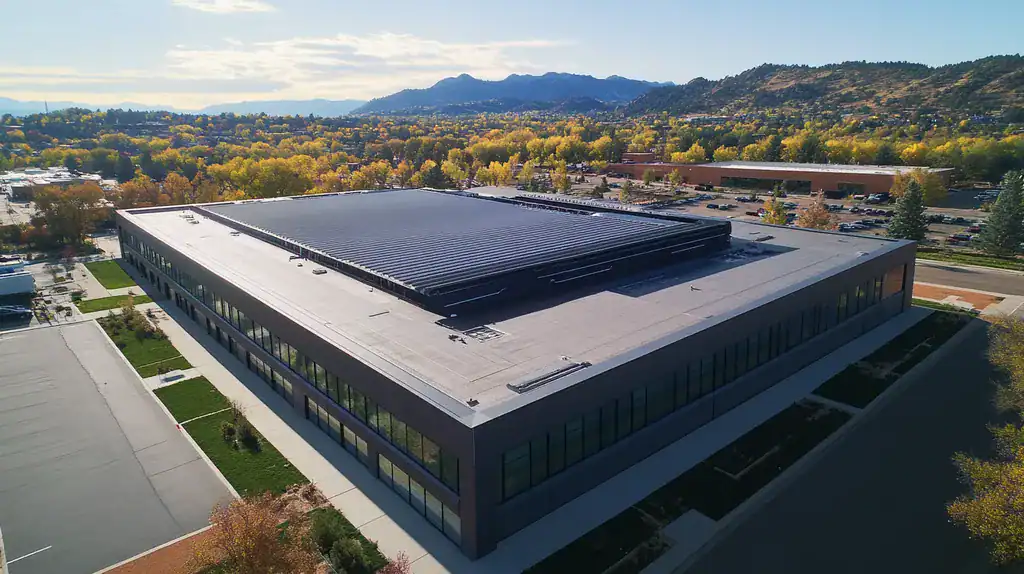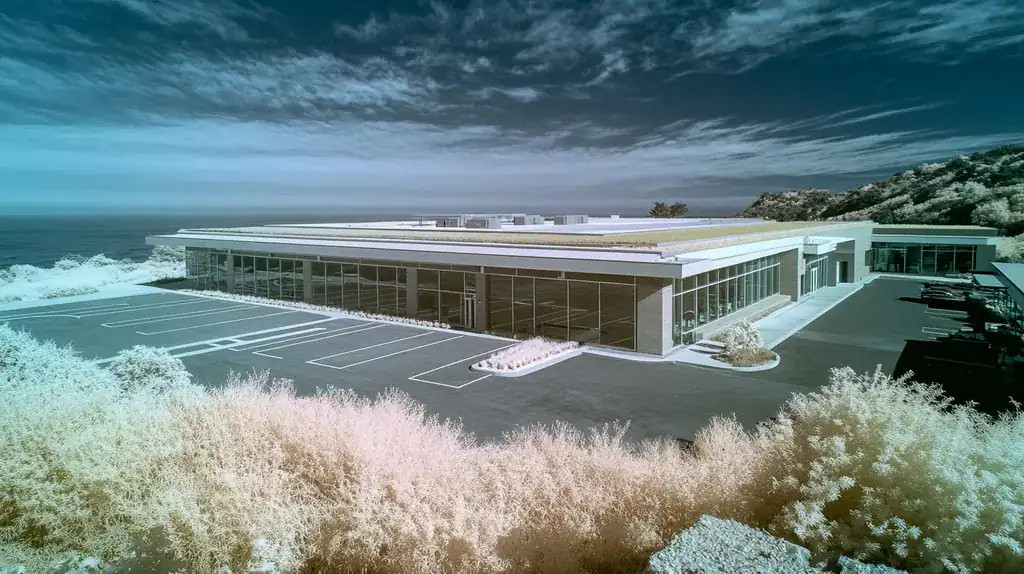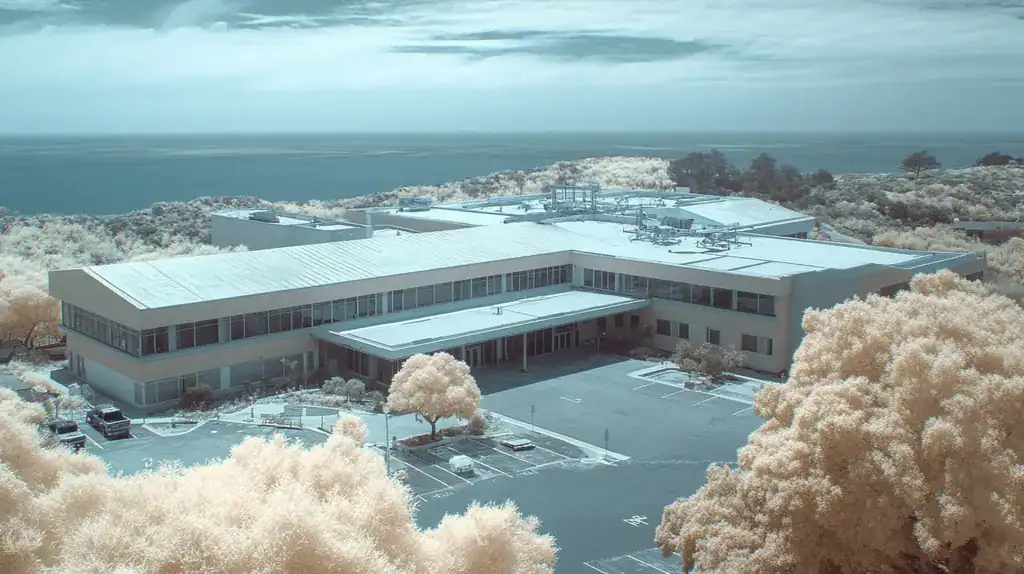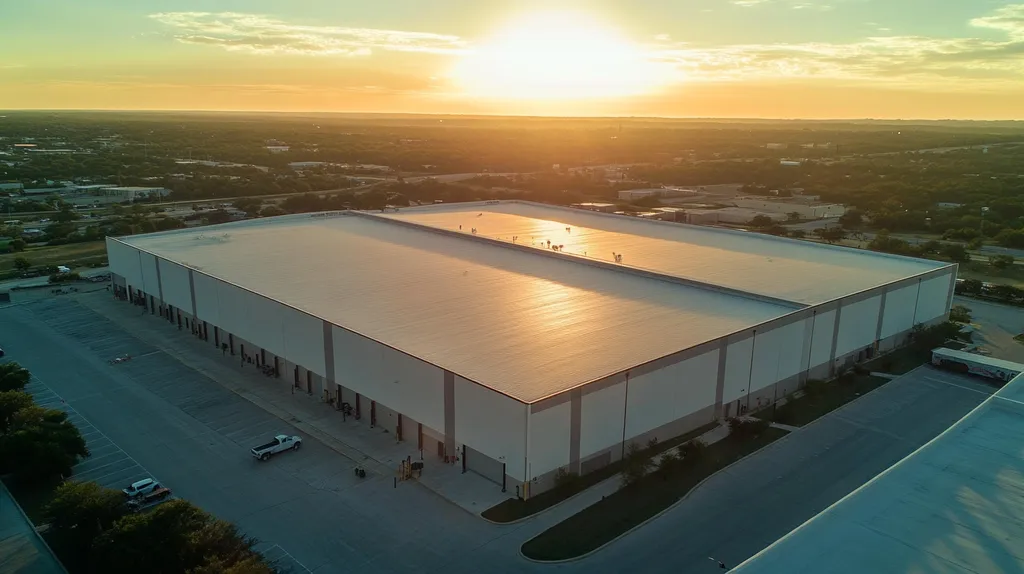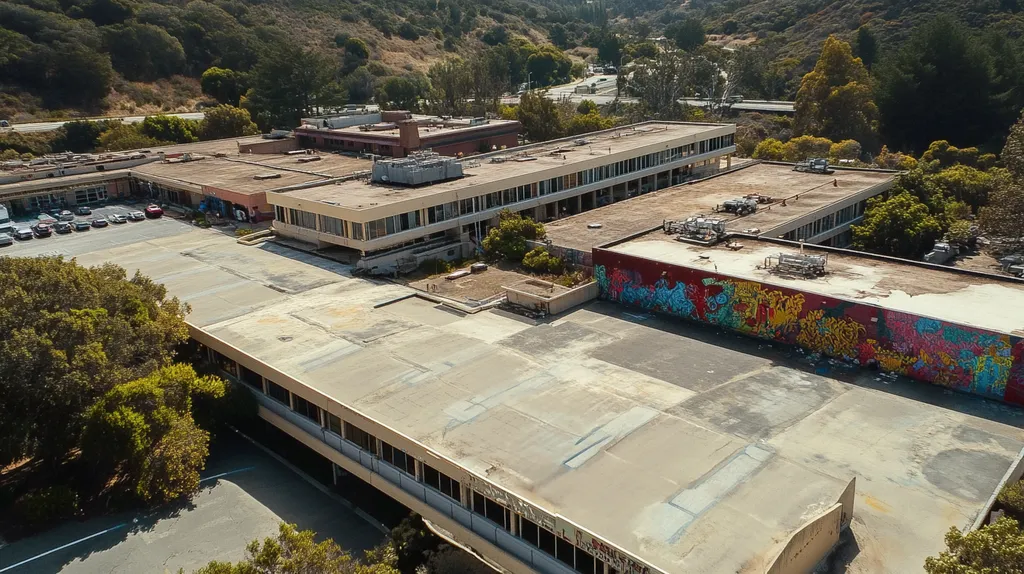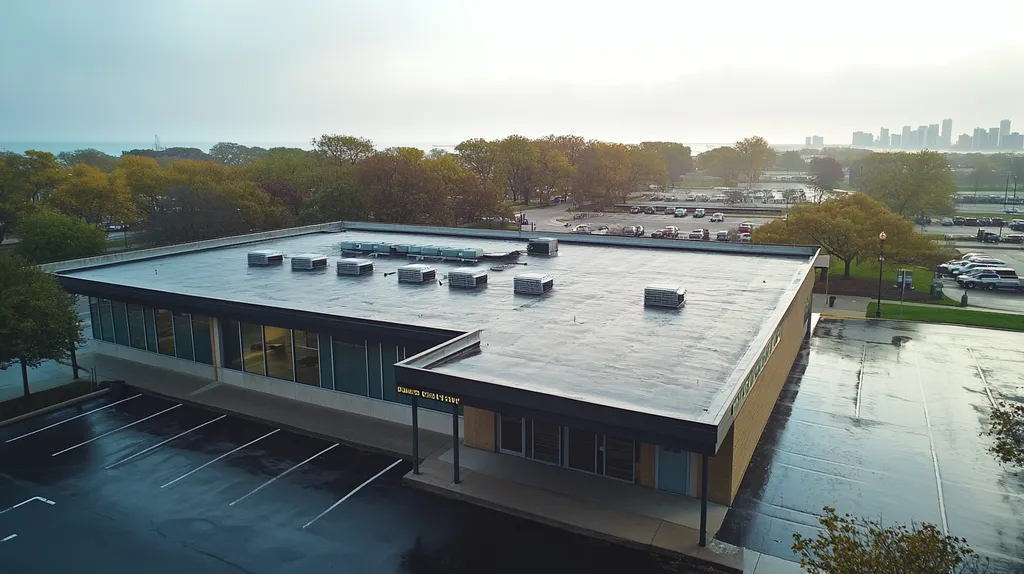In an era where commercial buildings account for 35% of U.S. energy consumption, roof coating practices promise sustainability but often deliver disappointment. Traditional approaches to roof coatings waste billions annually through premature failures, harmful chemical emissions, and missed opportunities for true environmental impact.
From VOC-laden formulations to inadequate installation standards, current coating methods are creating a sustainability deficit that grows with each application cycle.
This critical examination reveals why established practices are falling short and explores how emerging technologies and smarter approaches can transform commercial roofs from energy liabilities into powerful sustainability assets.
SECTION 1: CURRENT PRACTICES
Picture your commercial roof as a superhero cape for your building – except this cape needs the right coating to maintain its powers! While traditional roof coating practices have served us well, they’re now facing their kryptonite: rising energy costs and environmental pressures. Did you know that poorly coated roofs can leak up to 35% of a building’s cooling straight into the atmosphere? That’s like leaving your freezer door open in the middle of summer!
Common Types of Commercial Roof Coatings
Welcome to the fascinating world of roof coatings, where not all heroes wear the same cape! Acrylic coatings are the popular kids on the block – affordable and UV-resistant, but they can be a bit high-maintenance, needing frequent touch-ups to keep their superpowers intact.
Silicone coatings are the waterproof warriors, laughing in the face of puddles and ponding water. However, they’ve got a slippery personality that can make maintenance crews nervous during wet weather.
Polyurethane coatings are the tough guys, ready to take a beating from foot traffic and debris. But watch out – they’re known for their strong personality (and smell) during application!
Think of these coatings as your building’s sunscreen – some are water-resistant, some last longer, and some need more frequent reapplication. The trick is matching the right type to your building’s specific needs and climate challenges.
Application Methods and Maintenance Cycles
Applying roof coatings is like frosting a giant cake – except this cake needs to withstand hurricanes! The process starts with a thorough cleaning that would make your grandmother proud, followed by careful preparation of the surface.
Most coatings need multiple layers, like wearing a t-shirt under your sweater for extra protection. Each layer must be applied with precise thickness and allowed proper drying time – rushing this process is like trying to paint your house during a rainstorm!
Regular check-ups are crucial, just like visiting your dentist (but less scary). Semi-annual inspections help catch small problems before they become roof-sized headaches.
Proper maintenance includes cleaning drainage systems, checking seams, and looking for signs of wear. Skip these steps, and your roof coating might decide to retire early!
Energy Efficiency Claims and Market Adoption
Roof coatings are an environmentally friendly option that can significantly reduce energy consumption and greenhouse gas emissions. By enhancing the energy efficiency of commercial buildings, these coatings support sustainability goals and contribute to a greener future. (source: Paul Banger Roofing)
The market resembles a game of telephone – everyone’s heard amazing stories about energy savings, but the actual numbers can get lost in translation. Some coatings promise the moon but deliver a nightlight!
Early adopters are leading the charge, especially in sunny regions where cooling costs can rival a small country’s GDP. These pioneers are showing that the right coating, properly maintained, can deliver meaningful energy savings.
The future looks bright (but thankfully reflected, thanks to cool roof technology!). As more buildings showcase successful implementations, the industry is moving toward more standardized performance metrics and verified efficiency claims.
SECTION 2: SYSTEMIC ISSUES
Think of your commercial roof like a shield that’s supposed to protect your building for decades. But here’s the shocking truth: many of today’s roof coatings are more like temporary band-aids than lasting armor! While building owners spend billions annually on these coatings, three major problems keep popping up like unwanted leaks. From coatings that wear out faster than a cheap umbrella to chemical formulas that make Mother Nature cry, it’s time to expose why current practices aren’t living up to their promises.
Durability Limitations and Premature Failures
Ever notice how some roof coatings seem to age like milk instead of wine? That’s because many popular coatings start breaking down just when they should be hitting their stride, sometimes failing in as little as 2-3 years in harsh climates.
The numbers tell a startling story: a coating that promises 15 years of protection might start peeling, cracking, or bubbling before your building’s next paint job. It’s like buying a car that starts rusting before you’ve paid off the loan!
Weather is playing rough these days, with extreme temperatures and wild storms becoming the new normal. Many current coatings simply can’t handle these meteorological mood swings.
The real kicker? When these coatings fail early, building owners face a triple whammy: replacement costs, potential interior damage, and the headache of scheduling another installation way ahead of schedule.
Environmental Impact of VOCs and Chemical Formulations
Here’s an uncomfortable truth: many traditional roof coatings are like walking around with a can of hairspray continuously spraying into the air. Their high VOC content isn’t just a technical term – it’s a real environmental villain!
These chemical cocktails don’t just disappear into thin air. They contribute to smog formation, can trigger respiratory issues, and some even help create that unwanted greenhouse effect we’re all trying to fight.
Building codes and environmental regulations are getting stricter faster than you can say “sustainability.” What’s acceptable today might land you in hot water (or hot air!) tomorrow.
The good news? Some innovative manufacturers are developing eco-friendly alternatives that work just as well without the environmental guilt trip. Think of it as switching from a gas-guzzling SUV to an electric vehicle – same destination, cleaner journey!
Ineffectiveness Against Underlying Roof Structural Problems
Applying a coating over structural issues is like putting a fresh coat of paint on a car with engine problems – it might look pretty, but it won’t fix what’s really wrong! Yet this band-aid approach has become surprisingly common in commercial roofing.
Hidden moisture is the sneaky saboteur here. When trapped between layers, it’s like having a time bomb in your roof, slowly deteriorating the structure from the inside out.
The domino effect can be devastating: what starts as a small leak can turn into a full-scale roofing disaster faster than you can say “insurance claim.” Many coating systems provide zero early warning signs of these underlying problems.
Smart building owners are catching on to this game of “hide the problem.” They’re demanding thorough structural assessments before any coating application, because nobody wants to pay twice for the same repair!
SECTION 3: MISSED OPPORTUNITIES
Ever wonder what happens when your roof’s potential goes untapped? It’s like having a solar-powered superhero who forgot to charge their powers! While building owners focus on basic maintenance, they’re missing out on roofing innovations that could slash energy bills and boost sustainability. Imagine your roof working triple-duty: defending against weather, fighting climate change, and shrinking utility costs. Yet many buildings are stuck with yesterday’s solutions, leaving money on the table and carbon in the atmosphere.
Integration with Comprehensive Roof Asset Management
Think of your roof coating as part of an orchestra, not a solo performer! When coatings play alone, they miss the harmony of a complete roof management strategy. Many buildings treat coating applications like one-hit wonders when they should be part of a greatest hits album.
Smart facility managers are discovering that coating maintenance schedules can dance in perfect rhythm with other roofing activities. This synchronized approach catches problems early, extends coating life, and maximizes protection.
Building owners who coordinate coating work with regular inspections and repairs save big bucks. It’s like having your mechanic check your oil while they’re already under the hood – efficient and cost-effective!
By tracking coating performance alongside other roof metrics, managers can spot trends and optimize timing for future applications. This data-driven approach turns reactive maintenance into proactive protection.
Leveraging Advanced Materials for Longevity
Would you fight modern battles with ancient weapons? That’s exactly what happens when buildings stick to outdated coating materials! Today’s advanced coatings are like space-age armor for your roof, engineered to battle UV rays, extreme weather, and thermal stress.
These super-coatings can stretch, flex, and bounce back like rubber bands, while old-school materials crack faster than eggs at a breakfast buffet. The durability difference isn’t just impressive – it’s revolutionary.
Modern coating systems can self-heal minor damage and adapt to temperature changes like chameleons changing colors. They’re not just tough; they’re smart!
The initial investment might make your wallet wince, but these materials pay for themselves through extended life spans and reduced maintenance needs. It’s like buying a premium appliance that outlasts three budget models.
Enhancing Reflectivity and Thermal Performance
Your roof could be working harder than a sunbather’s umbrella to keep your building cool! The latest reflective coatings don’t just bounce back sunlight – they transform your roof into an energy-saving powerhouse.
Picture your roof as a mirror wearing sunscreen. The right coating can reflect up to 85% of solar heat, keeping your building cooler naturally. That means your AC system can take more coffee breaks!
Most buildings are missing out on the thermal performance party. Modern coatings can reduce roof surface temperatures by up to 50°F – that’s like giving your building its own personal shade tree.
The math is simple: better reflection equals lower temperatures, which leads to reduced cooling costs and a smaller carbon footprint. This sustainable solution helps both the planet and your budget.
SECTION 4: ROOT CAUSES
Want to know why so many commercial roofs are performing more like leaky umbrellas than reliable shields? It’s like trying to build a house with mismatched puzzle pieces! Three sneaky culprits are sabotaging sustainability efforts across the industry: questionable product choices, installation teams working without a playbook, and building owners trying to patch when they should replace. The result? A perfect storm of waste, inefficiency, and missed opportunities that’s costing both buildings and the environment.
Inadequate Specification and Product Selection
Imagine sending a snowboarder to surf tropical waves – that’s what happens when the wrong coating meets the wrong roof! Unfortunately, this mismatch occurs more often than you’d think, with property owners choosing products based on price tags instead of performance needs.
The coating marketplace is like a massive buffet where not everything on the menu suits your dietary needs. Without proper guidance, building owners often select products that look good on paper but crumble under real-world conditions.
Temperature swings, UV exposure, and local weather patterns should drive coating choices. Yet many specifications read like they were copied from a different climate zone entirely!
The cost of getting it wrong? A coating that deteriorates faster than ice cream on a hot sidewalk, leaving buildings vulnerable and sustainability goals melting away.
Insufficient Training and Installation Quality Control
Even the world’s best coating can’t work miracles if it’s applied like finger paint at a preschool! Too many installation crews lack the training needed to handle today’s advanced coating systems.
Quality control often consists of crossing fingers and hoping for the best. Without proper oversight, crucial steps get skipped faster than commercials during your favorite TV show.
Temperature, humidity, and surface preparation all play starring roles in coating success. But on many job sites, these factors get treated like extras in a B-movie.
The result is a coating that might look great on day one but starts showing its true colors (literally!) when the warranty ink is barely dry. No amount of sustainability planning can overcome poor installation practices.
Overreliance on Coatings as a Roof Replacement Substitute
Using coatings to avoid necessary roof replacement is like putting a Band-Aid on a broken arm – it might cover the problem, but it won’t fix what’s really wrong! Yet building owners increasingly treat coatings as magic wands that can solve any roofing issue.
This “coat and hope” approach ignores underlying structural problems that no amount of coating can cure. Moisture-laden insulation, failing seams, and deteriorated substrates don’t magically disappear under a fresh coat.
The hard truth? Sometimes a roof needs more than just another layer of protection. Coatings work wonders when used correctly, but they’re not resurrection specialists for dead or dying roofs.
Smart building owners recognize that coatings complement – but don’t replace – proper roof maintenance and timely replacement. It’s about using the right tool for the right job, not finding creative ways to avoid the inevitable.
DATA DRIVEN EVIDENCE
Think of your commercial roof as Earth’s sunscreen – except this sunscreen needs some serious fact-checking! While building owners chase quick fixes and temporary solutions, the numbers tell a different story. Your roof isn’t just keeping the rain out – it’s either fighting climate change or contributing to it. Let’s dive into what the data really says about current coating practices, and why that “bargain” coating might cost more than just dollars.
Life Cycle Assessments Highlighting Environmental Costs
Imagine tracking your roof coating’s entire life story, from its birth in a factory to its retirement party! That’s exactly what Life Cycle Assessments (LCAs) do, and the story they tell isn’t always pretty.
The numbers are eye-opening: producing traditional coatings can generate more carbon emissions than they’ll ever help prevent. It’s like buying an electric car that runs on coal-powered electricity!
Many coatings start decomposing faster than a banana in summer, releasing harmful compounds into the environment. This chemical breakdown isn’t just bad for the planet – it’s terrible for your warranty!
Smart building owners are learning to read these life stories before making coating decisions. After all, wouldn’t you want to know if your roof’s “sunscreen” was actually causing more environmental sunburn?
Energy Savings and Emission Reduction Metrics
Let’s talk numbers that would make your utility bill smile! Modern reflective coatings can bounce back up to 85% of solar heat, turning your roof from a heat sponge into a light show.
Building temperature data tells an impressive story: properly coated roofs can stay up to 50°F cooler than uncoated surfaces. That’s like giving your air conditioning system a summer vacation!
The math gets even better when you look at the big picture. Buildings with optimized coating systems report cooling cost reductions of 20-30%, proving that sometimes the best energy is the energy you don’t use.
But here’s the kicker: these savings only happen when coatings are selected and applied correctly. It’s like having a high-performance sports car – it only works its magic when you use it right!
Correlation Between Coating Performance and Roof Age
Your roof ages like fine wine – but not all coatings can keep up with the vintage! Research shows that coating performance takes a nosedive when applied to older roofs without proper preparation.
The numbers tell a sobering tale: coatings applied to 10+ year-old roofs often fail 40% faster than those applied to newer surfaces. It’s like trying to paint over rust – without treating the problem, you’re just hiding the countdown to failure.
Temperature fluctuations hit aging roofs harder than their younger cousins. When standard coatings can’t flex with these movements, they crack faster than eggs at a Sunday brunch.
The solution lies in matching coating systems to roof age. Just as you wouldn’t use the same skincare products at 50 that you did at 20, your aging roof needs age-appropriate coating care!
SECTION 6: ALTERNATIVE SOLUTIONS
Your commercial roof is like a superhero in desperate need of an upgrade! While traditional coatings play Captain Yesterday with outdated materials and methods, modern solutions are ready to sweep in like the sustainability Avengers. Did you know that the right combination of advanced materials and smart technology can slash your building’s cooling costs by up to 30%? It’s time to trade in that phone booth costume for a high-tech suit that actually saves the day!
Use of High-Performance, Low-VOC, and Renewable Materials
Welcome to the future of roofing, where coatings act more like Iron Man’s suit than a plain old raincoat! Today’s high-performance materials don’t just protect – they actively adapt to environmental challenges while keeping harmful emissions at zero.
Plant-based and bio-engineered coatings are revolutionizing the industry faster than you can say “photosynthesis.” These materials offer the durability of traditional coatings without the environmental guilt trip.
Imagine a coating that heals its own scratches and adjusts its properties based on temperature – that’s not science fiction, it’s happening right now! These smart materials can extend your roof’s life while reducing maintenance headaches.
The best part? These advanced materials often cost the same or less than traditional options when you factor in their longer lifespan and reduced maintenance needs. It’s like getting a luxury car for the price of a clunker!
Combining Coatings with Preventive Roof Repairs
Think of your roof like a prize fighter – it needs both armor and agility to go the distance! Modern coating strategies don’t just cover problems; they team up with preventive repairs to create an unbeatable defense system.
Smart building owners are learning to “tag team” their roof maintenance. When minor repairs meet cutting-edge coatings, they create a synergy that extends roof life far beyond traditional expectations.
The secret sauce? Timing! By coordinating repairs and coating applications, you create a maintenance rhythm that catches small issues before they become big problems. It’s like having a roof doctor who prevents diseases instead of just treating symptoms.
This dynamic duo approach can cut emergency repair costs by up to 60% while extending the time between major replacements. Now that’s what we call a knockout combination!
Adoption of Smart Roof Technologies for Monitoring and Longevity
Your roof is ready to join the Internet of Things revolution! Smart sensors are like having thousands of tiny roofing experts on patrol 24/7, monitoring everything from moisture levels to thermal performance.
These high-tech helpers can spot problems faster than a caffeinated building inspector. They’ll alert you to potential issues before they become visible, saving you from those “surprise” repair bills that nobody loves.
Modern monitoring systems can even predict when your roof will need maintenance, letting you schedule repairs during optimal weather windows. It’s like having a meteorologist and maintenance planner rolled into one!
Roof coatings are an environmentally friendly option that can significantly reduce energy consumption and greenhouse gas emissions. By enhancing the energy efficiency of commercial buildings, these coatings support sustainability goals and contribute to a greener future. (source: Paul Banger Roofing)
Moving Forward
The $7 billion commercial roof coating industry stands at a critical crossroads between outdated practices and sustainable innovation.
Traditional coating methods waste over $2 billion annually through premature failures while releasing thousands of tons of VOCs into the atmosphere.
Yet emerging solutions combining smart technologies, renewable materials, and preventive maintenance strategies demonstrate that coatings can deliver on their sustainability promises when properly specified and applied.
The future of commercial roof sustainability depends on abandoning the “coat and hope” mentality in favor of integrated approaches that leverage advanced materials and monitoring systems.
For the 5 million commercial buildings in the U.S., the choice is clear: evolve coating practices now or face mounting financial and environmental costs later.
FREQUENTLY ASKED QUESTIONS
Q. What are common practices for maintaining a commercial roof?
A. Regular maintenance for your roof involves cleaning drainage systems, inspecting seams, and scheduling semi-annual check-ups. Each layer of coating should be applied carefully to ensure longevity. This prevents small issues from escalating into major repairs!
Q. How does a commercial roof impact the environment?
A. Coatings can significantly affect the environment, especially if they contain high VOC levels. These compounds contribute to smog and other air quality issues. Choosing eco-friendly coatings can help minimize your roof’s environmental footprint.
Q. Can a roof coating improve energy efficiency for an industrial roof?
A. Absolutely! A good roof coating reflects sunlight, reducing heat absorption. This keeps your building cooler and lowers energy costs, leading to significant savings on cooling bills and improved energy efficiency overall.
Q. How often should I apply a new coating to my commercial roof?
A. The frequency of application depends on the coating type and local weather conditions. Generally, every 5-10 years is a good estimate, but regular inspections can help determine the optimal timing for your specific roof needs.
Q. What are the risks of using outdated coating materials on a commercial roof?
A. Outdated materials may not offer adequate protection against UV rays or harsh weather. They can deteriorate quickly, leading to frequent repairs and potentially costly damages. It’s essential to use modern coatings tailored to current climate challenges!
Q. How do I choose the right coating for my industrial roof?
A. Consider factors like climate, roof type, and durability needs. Consult with a roofing expert to identify the specific requirements for your roof, ensuring you choose a coating that provides long-term protection and meets performance standards.
Q. What technological advancements are available for commercial roofs?
A. Modern roofs can utilize smart technologies, including sensors to monitor roof conditions such as moisture and temperature. This proactive monitoring can help catch issues early, maximizing the roof’s lifespan and efficiency while saving on maintenance costs!

